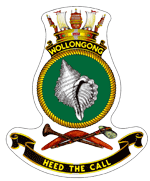World War II
After entering active service, Wollongong was deployed as a convoy escort in Australian waters. [1] On 11 January 1942, she was sent to Singapore. [1] The corvette was involved in patrols and the evacuation of Allied personnel from Malaya, Java, and Sumatra, and was the last Australian ship to leave Singapore before it was surrendered to the Japanese on 15 February. [1] She then provided a rear escort to a convoy fleeing Tanjong Priok, Batavia. [1] During this, Wollongong, stood by the tanker HMS War Sidar, which ran aground and eventually had to be abandoned, was forced to sink the minesweeper HMS Gemas, which attempted to turn back to the captured port, and broke off from the convoy to escort the damaged SS British Judge, which was torpedoed on the night of 28 February and could not keep up. [1] The main convoy and the escorting sloop HMAS Yarra was sunk on 4 March by a Japanese cruiser group. [1]
Wollongong was then ordered to Fremantle, where she served as an escort ship before sailing on 14 September to Diego Garcia to join the British Eastern Fleet. [1] She operated in the Indian Ocean, Persian Gulf, Arabian Sea, and Mediterranean as a convoy escort and patrol vessel, and twice entered the Atlantic Ocean to meet Mediterranean-bound convoys. [1] In September 1943, while in the Mediterranean, Wollongong was called on to shell the beached German submarine U-617, and was awarded partial credit for the submarine's destruction. [1]
Wollongong returned to Australian waters in February 1945, then was assigned to the British Pacific Fleet. The corvette was involved in the Battle of Okinawa. [1] After the end of World War II, Wollongong was sent to the Far East, where she was involved in anti-piracy patrols, before returning to Australia at the end of 1945. [1]
The ship received six battle honours for her wartime service: "Pacific 1942–45", "Indian Ocean 1942–45", "Sicily 1943", "Mediterranean 1943", "East Indies 1943", and "Okinawa 1945". [10] [11]

